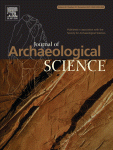On the west side of the Winnemucca Lake subbasin, Nevada, distinctive deeply carved meter-scale petroglyphs are closely spaced, forming panels on boulder-sized surfaces of a partially collapsed tufa mound. The large, complex motifs at this side are formed by deeply carved lines and cupules. A carbonate crust deposited between 10 200 and 9800 calibrated years B.P. (ka) coats petroglyphs at the base of the mound between elevations of 1202 and 1206 m. Petroglyphs above the carbonate crust are carved into a branching form of carbonate that dates to 14.8 ka. Radiocarbon dates on a multiple-layered algal tufa on the east side of the basin, which formed at an elevation of 1205 m, as well as a sediment-core-based total inorganic carbon record for the period 17.0–9.5 ka indicate that water level in the Winnemucca Lake subbasin was constrained by spill over the Emerson Pass Sill (1207 m) for most of the time between 12.9 ± 0.3 and ≥9.2 ka. These and other data indicate that the lake in the Winnemucca Lake subbasin fell beneath its spill point between 14.8 and 13.2 ka and also between 11.3 and 10.5 ka (or between 11.5 and 11.1 ka), exposing the base of the collapsed tufa mound to petroglyph carving. The tufa-based 14C record supports decreased lake levels between 14.8–13.2 ka and 11.3–10.5 ka. Native American artifacts found in the Lahontan Basin date to the latter time interval. This does not rule out the possibility that petroglyph carving occurred between 14.8 and 13.2 ka when Pyramid Lake was relatively shallow and Winnemucca Lake had desiccated.


 - I'll have to remember that word and use it in the field as they can be seen around here every day.
- I'll have to remember that word and use it in the field as they can be seen around here every day.